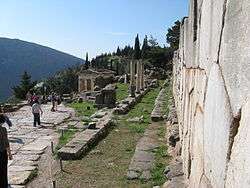Stoa of the Athenians

The Stoa of the Athenians is an ancient portico in the Sanctuary of Apollo in Delphi, Greece, located south of the Apollo Temple. The southern side of the polygonal wall of the platform forms the north wall of the stoa. It was constructed c. 478 BC-470 BC during the early Classical period. The one-aisled stoa with Ionic colonnade opens toward the southeast. It was dedicated by the Athenians after the Persian Wars.
Description
The Stoa of the Athenians is built against the polygonal wall supporting the terrace of the temple of Apollo. The monument has been identified through the inscription of the stylobate: Ἀθεναῖοι ἀνέθεσαν τὲν στοὰν καί τὰ ℎόπλ̣α καὶ τἀκροτέρια ℎελόντες τōν πολεμίον [The Athenians dedicated the portico and the ropes and the figure heads of the ships that they seized from the enemies].The "ropes" mentioned in the inscription refer probably to those snatched from Persian ships.[1] On a three-stepped stylobate measuring 26.5 meters long and 3.10 meters wide stand seven monolithic fluted columns of the Ionic order. They are made of Pentelic marble and their bases are made of Paros marble. They are 3.31 meters high.The distance between them is quite large, thus creating openings allowing ample light to enter the building, which was probably covered with a wooden roof. Τhe stylobate and the colonnade have been restored and are extant today in situ. On the polygonal wall at the back of the stoa, particularly on the western part, have been carved about six hundred manumission inscriptions, in the form of fictitious sale of slaves to the god. Most probably, the portico was constructed after the naval victories against the Persians at Mykale and Sestos in 478 B.C.[2] It was used for storing the war spoils, mainly from naval victories against the Persians. War spoils from naval battles at Mykale, Sestos, Salamis and the Hellespont were included.[3]
Background
The remains of the Stoa of the Athenians were discovered by Bernard Haussoullier in 1880. The stoa was constructed in Delphi after the naval victory over the Persians at Hellespont in 478 BC.[4] It was dedicated to Apollo, and the Athenians that perished in the Greco-Persian Wars.[5] The location of the Stoa was just to the southeast of Apollo's Temple. Towards the end of the Greco-Persian Wars, Xerxes ordered the construction of two pontoon bridges across the Hellespont.[6] The Athenians and islanders dismantled the bridges connecting Mycale to Hellespont, and returned home bringing the cables from the bridges.[7] These cables were to be dedicated in their temples. The Stoa was initially built to exhibit the spoils of war when the Athenians defeated the Persians. However, in the following years, more exhibits were but displayed on the Stoa as the Athenians gained more naval victories. The war memorials on display were dedicated to the Greek gods, but the memorials also served as monuments of Athens victory. Of the entire Stoa, only the rear polygonal wall, stylobate, and northeast foundations, with a few columns remain today.[8][9]

Design
A typical Stoa is a Greek portico composed of a back wall and a colonnaded wall up front. The Stoa of the Athenians used a pre-existing wall as its back wall. The pre-existing wall served as a foundation of the terrace supporting the Temple of Apollo. The Stoa of the Athenians was built with a wooden, shedded roof with hipped ends, a wooden entablature, a 3.58-meter intercolumniation, a .39-meter lower column diameter. Unlike most stoas, the Stoa of the Athenians was constructed from marble in the Ionic order. It was built with a total of Seven fluted marble columns. Although the rafters were never recovered, evidence suggests that they spanned across the roof at 3.5-meter intervals.[10]
Bibliography
- Amandry, P., « Le portique des Athéniens à Delphes », BCH 70, 1946, 1-8
- Bommelaer, J.-F., « Les Portiques de Delphes », RA 1993, 33-51.
- Bommelaer, J.-F., Laroche, D., Guide de Delphes. Le site, Sites et Monuments 7, Paris 1991, 147-150.
- Christopher Mee & Antony Spawforth, Greece (An Oxford Archaeological Guide). Oxford/ OUP, 2001, p. 307-309.
- Coulton, J. J., The Architectural Development of the Greek Stoa, Oxford 1976, 234.
- Haussoullier, B., "Le Portique des Athéniens et ses abords,", BCH 5, 1881, 1-19.
- Photios Petsas, Delphi : Monuments and Museum. Athens : Krene Editions, 2008, p. 47.
- Robin Barber, Greece (Blue Guide), London- N.Y. 2001 (Revised reprint of the 6th edition of 1995), pp. 397.
- Umholz, G., “Architraval Arrogance? Dedicatory Inscriptions in Greek Architecture of the Classical Period”, Hesperia 71, 2002, 261-293.
- Walsh, J., « The Date of the Athenian Stoa at Delphi», AJA 90, 1986, 319-336.
References
- ↑ Umholz, G., “Architraval Arrogance? Dedicatory Inscriptions in Greek Architecture of the Classical Period”, Hesperia 71, 2002, 261-293.
- ↑ Walsh, J., « The Date of the Athenian Stoa at Delphi», AJA 90, 1986, 319-336.
- ↑ Raptopoulos, S. (2012). "The Stoa of the Athenians". ΟΔΥΣΣΕΥΣ. Ministry of Culture and Sports, Greece. Retrieved 29 June 2013.
- ↑ "Ministry of Culture and Sports | The Stoa of the Athenians". odysseus.culture.gr. Retrieved 2017-11-14.
- ↑ Amandry, Pierre. "Le portique des Athéniens à Delphes". Bulletin de correspondance hellénique (in French). 70 (1): 1–8. doi:10.3406/bch.1946.2549.
- ↑ Tom., Holland, (2006). Persian fire : the first world empire and the battle for the West. London: Abacus. ISBN 9780349117171. OCLC 71139318.
- ↑ Russell., Meiggs, (1972). The Athenian empire. Oxford: Clarendon Press. ISBN 0198148437. OCLC 481738.
- ↑ "DELPHI: Stoa of the Athenians". www.coastal.edu. Retrieved 2017-11-14.
- ↑ "Gate to Greece: Phokis, Central Greece: Delphi Delfi: Stoa of Athenians and Polygonal Wall". www.mesogeia.net. Retrieved 2017-11-19.
- ↑ "DELPHI: Stoa of the Athenians". www.coastal.edu. Retrieved 2017-11-19.
External links
| Wikimedia Commons has media related to Stoa of the Athenians. |
Coordinates: 38°28′55.68″N 22°30′6.72″E / 38.4821333°N 22.5018667°E